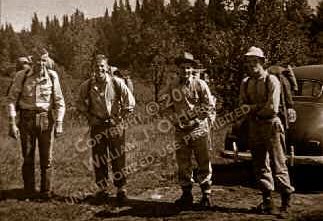Trials of Youth: Fred R. Studer was one of the youthful backpackers Noah referenced in his 14 September 1946 entry. “We knew very little about Noah John Rondeau. “

The Hermit and Us – Our Adirondack Adventures with Noah John Rondeau
The Trials of Youth
An excerpt from “The Hermit and Us”, Starting on page 168
Saturday, September 14, 1946
At Beauty Parlor.
A perfect September day. 4 men call
(3 Schenectady and 1 Michigan).
I see Venus 40 times in 3 hours before sundown.
—Noah John Rondeau’s memorandum
Fred R. Studer was one of the youthful backpackers Noah referenced in his 14 September 1946 entry. In Studer’s 1991 interview, he told me an interesting observation he made during his group’s end-to-end Northville- Lake Placid trek. “The natives of the Adirondacks had a different outlook on life than the partners in my group.” For example, “The average native [of the mountains] couldn’t understand why anyone would take their leisure time and climb mountains.”
Studer continued his recollection of September 14, 1946:
We were lacking many of the conveniences available today. Dried potatoes and dried eggs were unavailable … in short, camping took a lot more planning, ingenuity, effort and so forth than it does now. In like manner I feel sure hermiting then was far more of a challenge than it would be now … We knew very little about Noah John Rondeau. As we approached his place we had no idea of what to expect. We did expect him to be sort of a backwoods, native, Adirondacks type.

Courtesy of Fred R. Sutor
1946. Bill White, Fred Studer, Bill Barzler and Phil Rumbolt. The backpackers talked about their future the entire camping trip. They had an opportunity to make a living in the civilized world or, kidded Fred, “We could become hermits. We might even make a name for ourselves.”
Earlier visitors described the hermit’s yard as a “pig pen.” It was unjust and false. When Fred Studer and his three college-bound friends approached the entrance to Rondeau’s bailiwick, which had become an almost legendary destination in the Adirondacks down through the years, they first spotted the tall wooden teepees on the horizon, then the tattered banner over the spur trail’s entry that announced Welcome to the City. Iron kettles planted in pansies hung from the center of pole tripods on each side of the proclamation. The man-made beauty on a semi-wooded sand bank aside the edge of a water waste — the flow ground—additionally greeted guests to the municipality. The host extended his typical hospitality. His greeting “had an air of formality.” On first reaching his cabin, the men were asked to “sign my guest register.”
So imagine the excitement of the four backpackers, raised in an urban environment, when they happened upon Noah just prior to his grand media exposure.